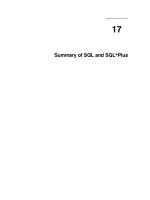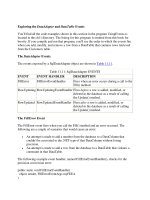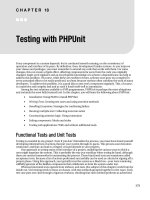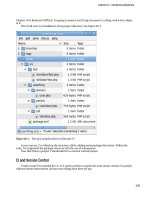Tài liệu LoopStar® SONET Access and Transport Solutions docx
Bạn đang xem bản rút gọn của tài liệu. Xem và tải ngay bản đầy đủ của tài liệu tại đây (236.59 KB, 4 trang )
2 fibers; one for working traffic and
one for protection traffic
Fiber break causes adjacent nodes to wrap the ring to avoid the outage
New Traffic path is out lined in yellow
1a
4a
3a3b
4b
7a
8a8b
7b
1b
2a
2b
6a
6b
5a
5b
UPSR Protection
LoopStar
®
SONET Access and Transport Solutions
SONET Add/Drop Multiplexer Rings
Overview
The LoopStar SONET product family provides traditional Add/Drop Multiplexer (ADM) functionality
to deliver TDM and data services. SONET has a long history as the service providers’ transport
mechanism of choice due to its reliability, traffic grooming capabilities, and simplified remote
management. With recent developments in Ethernet over SONET (EOS), SONET ADMs now have
the capability to effectively groom Ethernet traffic onto the SONET backbone. With the rise in
FTTX deployments for triple play, and the SONET ADM’s ability to effectively transport both TDM
and Ethernet traffic, the demand for SONET add/drop rings will continue to increase.
Reliability
SONET was designed to provide protection switching in the event of facility or equipment failures.
There are two basic protection switch mechanisms for ring topologies: Unidirectional Path
Switched Rings (UPSR) and Bidirectional Line Switched Rings (BLSR). All LoopStar SONET products
support UPSR, with the LoopStar 1600 supporting BLSR.
Unidirectional Path Switched Rings (UPSR)
UPSR makes switching decisions based on the signal quality of a single STS or VT. With UPSR
rings, two counter-rotating rings are used, one for the working traffic and one for the protection
traffic. Since UPSR is implemented at the path level only, nodes that terminate the path level are
the only ones capable of performing the protection switch. Therefore, the only nodes that can
perform a protection switch are those that are terminating the STS or VT. When a UPSR ADM
determines that a given path signal requires a protection switch, it wraps the ring by selecting the
protection path as the new active path. UPSR is typically used in access or smaller metro networks
where a hub node aggregates the traffic. All LoopStar SONET products support UPSR protection
switching.
APPLICATION NOTE
www.adc.com • +1-952-938-8080 • 1-800-366-3891
10/05 • 1339234
LoopStar
®
SONET Access and Transport Solutions
LoopStar
®
SONET Access and Transport Solutions
SONET Add/Drop Multiplexer Rings
2
www.adc.com • +1-952-938-8080 • 1-800-366-3891
Bidirectional Line Switched Rings (BLSR)
BLSR makes switching decisions based on the performance monitoring of the STS-1s at the line
level. As a result, the adjacent nodes to a failure are the nodes that perform the protection switch.
BLSR reserves half the bandwidth on a given line for working traffic and the other half for
protection traffic. Instead of UPSR’s counter-rotating rings, BLSR uses bidirectional optical
connections between nodes with half the working and protection traffic on both lines. Unlike UPSR,
when a protection switch occurs, all traffic (any STS or VT on the line) is switched from the working
path to the protection path. This is extremely effective in larger, meshed networks where the
bandwidth reuse capabilities of a BLSR network can be fully utilized. The LoopStar 1600 supports 2-
fiber BLSR for meshed or virtually meshed deployments over a SONET ring.
Traffic Grooming
Time Division Multiplexing (TDM)
TDM traffic grooming has been an integral part of SONET transport since its inception. After all,
SONET was designed to allow the efficient multiplexing of DSn signals. Traffic grooming as it applies
to SONET refers to the process of de-multiplexing an STS/VT1.5 from a higher level STS Synchronous
Payload Envelope (SPE) and dropping it out as a DSn signal. Likewise, a DSn signal can be added
into an SPE through the reverse process. By performing grooming at a VT level, the LoopStar SONET
product family permits different services to be transported to different locations without reserving
more than a DS-1’s worth of bandwidth.
Ethernet Over SONET
Traditionally, Ethernet over SONET has fallen under the classification of Packet Over SONET (POS).
POS refers to the process of mapping data traffic into one or more STS-1s. Since the multiplexing
scheme for SONET was designed for rates associated with TDM traffic, POS services, which were
implemented at rates of 10/100/1000 Mbps, could not be transported without taking up more
bandwidth than what was needed. Recently, developments in mapping Ethernet over SONET have
made it possible to efficiently transport Ethernet without wasting bandwidth. These new
developments are the Generic Framing Procedure (GFP), Virtual Concatenation (VCAT), and Link
2 fibers; each carrying 1/2 working
and 1/2 protect channels
Working channels on Span 6a switch to protect channels on Span 6b
1a
4a
3a3b
4b
7a
8a8b
7b
1b
2a
2b
6a
6b
5a
5b
BLSR Protection
Capacity Adjustment Scheme (LCAS), which are explained in detail in the LoopStar 800 Ethernet
Business Service Delivery Applications note #1315119 on adc.com. With support for EOS, the LoopStar
SONET product family can effectively transport Ethernet over the SONET network at even VT1.5 levels
Remote Management
Remote management is one of the key advantages of SONET networks. SONET was designed with an
embedded in-band channel, known as the Data Communications Channel (DCC), to interconnect nodes
for remote management. Historically, these nodes used the Open Systems Interconnection (OSI) protocol
stack to manage these nodes. Newer equipment uses an IP protocol stack to interconnect the nodes.
The LoopStar product family implements both the IP and OSI protocol stacks to provide remote
management through legacy and next-generation networks. This allows nodes to be automatically
discovered and the management traffic to be sent to the user-defined Gateway Network Element (GNE).
The GNE is responsible for terminating the DCC and delivering the management traffic via a 10/100BT
interface to the data communications network (DCN). Any of the LoopStar SONET products can be
designated as the GNE for one or more rings (multi-ring support is available on the 1600 and 800).
Summary
The LoopStar SONET product family provides a full-featured SONET portfolio to support the transport of
TDM and data traffic. With full support for SONET protection, traffic grooming, and remote
management, service providers can implement the type of network best suited for their environment.
10/05 • 1339234
LoopStar
®
SONET Access and Transport Solutions
LoopStar
®
SONET Access and Transport Solutions
SONET Add/Drop Multiplexer Rings
3
www.adc.com • +1-952-938-8080 • 1-800-366-3891
ADC Telecommunications, Inc., P.O. Box 1101, Minneapolis, Minnesota USA 55440-1101
Specifications published here are current as of the date of publication of this document. Because we are continuously
improving our products, ADC reserves the right to change specifications without prior notice. At any time, you
may verify product specifications by contacting our headquarters office in Minneapolis. ADC Telecommunications,
Inc. views its patent portfolio as an important corporate asset and vigorously enforces its patents. Products or
features contained herein may be covered by one or more U.S. or foreign patents. An Equal Opportunity Employer
1339234 10/05 Original © 2005 ADC Telecommunications, Inc. All Rights Reserved
Web Site: www.adc.com
From North America, Call Toll Free: 1-800-366-3891 • Outside of North America: +1-952-938-8080
Fax: +1-952-917-3237 • For a listing of ADC’s global sales office locations, please refer to our web site.
APPLICATION NOTE









